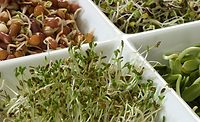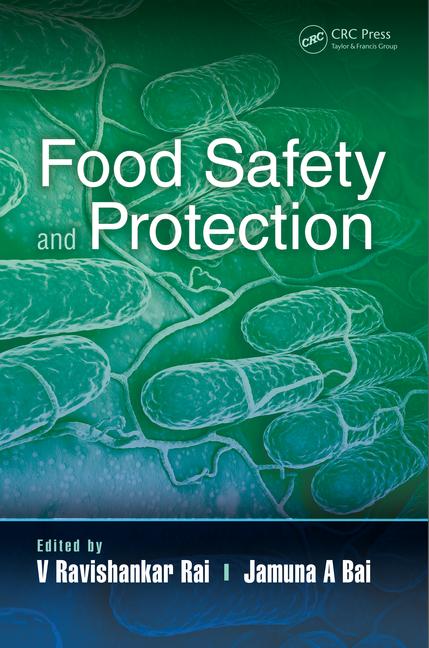Outbreak Responders Work to Stop Viral and Parasitic Foodborne Outbreaks

The U.S. Food and Drug Administration (FDA) regulates most food products in the United States, from the lettuce you put in your family’s dinner salad to the eggs and juice you serve for breakfast. In the current global market, much of that food comes from other nations. As of 2011, roughly one in six FDA-regulated food products consumed in the United States comes from abroad. And the percentage is much higher in foods like fruits (about 50 percent) and vegetables (about 20 percent).
So when a foodborne outbreak occurs within the United States and the suspect product is one of foreign origin, government agencies and food producers must work together efficiently to identify the cause of the outbreak. In 2013, federal, state, local and international outbreak responders worked together to stop one viral and at least two parasitic foodborne outbreaks that affected nearly 900 people in more than 30 states.
Hepatitis A Outbreak
FDA’s Coordinated Outbreak Response and Evaluation (CORE) Network worked with the U.S. Centers for Disease Control and Prevention (CDC) and state and local officials to investigate a multi-state outbreak of hepatitis A illnesses associated with a brand of frozen mixed berries in the late spring of 2013.
CORE’s Signals and Surveillance Team became aware of the outbreak in late May, and before the end of the month, FDA had begun a full outbreak response. By that time, CDC, working with state and local health agencies, had identified more than two dozen hepatitis A illnesses among people who had not traveled internationally in the previous 6 months and had no other clear exposure to the virus. This was particularly odd because the outbreak strain was from a subtype rarely seen in North America but that circulates widely in North Africa and the Middle East.
Most of those who got sick reported eating Townsend Farms Organic Antioxidant Blend of frozen mixed berries. By the end of the outbreak, CDC reported that 165 people in 10 states had become ill with hepatitis A after eating this fruit blend. The Townsend Farms blend had also been used in several coffee shops to make smoothies.
On May 31, 2013, CDC and FDA made public announcements about the outbreak and the link to the berry blend from Townsend Farms. These announcements alerted consumers to the risk but also advised people who had been exposed in the previous 14 days to see their healthcare provider about getting the hepatitis A vaccine. State and local health officials responded by making vaccinations available to those who had been recently exposed. National wholesale club Costco, which had carried the product in some stores, also offered the vaccinations to its customers.
On June 4, 2013, Townsend Farms Inc. recalled certain lots of the suspect product, which had been sold at Harris Teeter stores as well as at Costco.
Knowing what people ate before becoming sick led to several actions, including the next step: determining which ingredient was carrying the virus and how to test for it. The blend contained dark tart cherries, pomegranate seeds, strawberries, red raspberries and blueberries; at the beginning of the outbreak, there was no approved testing protocol for detecting the hepatitis A virus in berries. The only protocol available was for hepatitis A virus detection in green onions. To respond to the challenge, FDA laboratories quickly developed a protocol for hepatitis A virus detection in berries and began using it to test samples.
At the same time, FDA investigators were inspecting the Townsend Farms facilities and collecting records in a search for the answer to what ingredient was causing the illnesses.
“This was especially complicated, as there were multiple ingredients from multiple countries, including the United States, Chile, Argentina and Turkey,” says Lt. Cmdr. Carla Tuite of the U.S. Public Health Service (USPHS) and the response team leader for this outbreak.
Epidemiologic data, collected through patient questionnaires and test results, had pointed toward the fruit blend, but it was up to FDA to build on that foundation and find the ingredient and its source.
Meanwhile, there were several domino-like reactions to the Townsend Farms recall. The use of the fruit blend in some coffee shops to make smoothies led to advisories by local health authorities to alert people to the risk and encourage those who had been recently exposed to be vaccinated.
By combining information gained from FDA’s traceback and trace-forward investigations and CDC’s epidemiological investigation, both agencies determined that the most likely vehicle for the hepatitis A virus was a common shipment of pomegranate seeds from Göknur Foodstuffs Import Export Trading Company of Turkey. FDA reviewed records and determined that the pomegranate seeds from this shipment were the only ingredient common to all of the recalled frozen fruit blends sold at Costco and Harris Teeter stores.
“This finding was the result of an incredible effort by FDA’s Seattle District Office,” says Tuite. “They worked night and day to analyze the company’s records and give us the answer we needed.”
FDA also discovered that pomegranate seeds from this shipment were used by Scenic Fruit Company to make Woodstock Frozen Organic Pomegranate Kernels, which prompted a product recall by that company on June 26.
Soon after, FDA announced that it would detain shipments of pomegranate seeds from Göknur if they were offered for import into the U.S. In early July, FDA formalized that action by placing Göknur on two separate Import Alerts, meaning that pomegranate products produced by that company will be detained until FDA has confidence that future shipments will not be contaminated. Göknur will have to submit documentation to FDA, demonstrating that it has made all relevant corrections to address contamination issues before being taken off Import Alert status. The Import Alert was still in effect as of late June 2015.
“This was an unusual outbreak involving a seldom-seen virus, but our strong new partnerships helped us overcome the challenge and protect the public,” says Kathleen Gensheimer, M.D., M.P.H., director of CORE. “CORE always stands ready to work with federal, state, local and international partners in the interests of foodborne illness prevention.”
Cyclosporiasis Outbreaks
A cyclosporiasis outbreak in the summer of 2013 further illustrated the need for national and international cooperation. By the time the outbreak was declared over, 631 people in 25 states had reported getting sick.
The CORE Signals and Surveillance Team first identified this as an outbreak for FDA action on July 4, from reports that identified more than 10 cases in several midwestern states. By July 11, when the major FDA response began, the 35 confirmed cases included 22 in Iowa and 12 in Nebraska, and case counts were growing daily.
“We knew this would be a major outbreak because the case count more than doubled within the first few days,” says USPHS Lt. Cmdr. Kari Irvin, the response team leader for this incident.
Extensive epidemiological and traceback analysis by FDA, CDC and state officials led to the identification of two separate outbreaks of illness from Cyclospora: one associated with bagged salad mix and the other with cilantro as the suspect vehicle. On July 30, 2013, Iowa and Nebraska state health officials announced that their analysis indicated that the outbreak in those states was linked to a salad mix served at Olive Garden and Red Lobster, both Darden chain restaurants. Those cases that hadn’t eaten at a Darden restaurant were most likely to have purchased fresh produce from a retail grocery store chain. In tracing the food back to its source, investigators identified a common supplier of both ingredients to Darden restaurants in Iowa and Nebraska, as well as to several grocery stores across both states.
“CORE played a key role here,” recalls USPHS Cmdr. Mark Glover, the Emergency Response Coordinator for FDA’s Kansas City District Office. “The states played a vital role in the beginning, but as more people became ill, they needed CORE’s resources to help with the traceback.”
FDA district offices, in conjunction with the Iowa Department of Public Health, Nebraska Department of Health and Human Services, the Texas Department of State Health Services and other state partners, collected invoices and bills of lading or spreadsheets from the distributors of the products to help identify products potentially associated with patients’ cases.
“Traceback was very difficult in this incident,” says Irvin. “The bag salad mix had many components and each had to be investigated, which took up a lot of time.”
Bagged salad mix components included iceberg and romaine lettuce, carrots and red cabbage. The FDA traceback investigation found that illness clusters at restaurants, mainly located in Iowa and Nebraska, were traced to a common foreign supplier, Taylor Farms de Mexico, S. de R.L. de C.V.
“CORE’s ability to rapidly mobilize its resources and work in close conjunction with partner agencies and the food industry in the United States and overseas played a major role in its ability to conduct this traceback,” says Gensheimer.
By late July, Iowa and Nebraska announced that the contaminated salad was no longer in the food supply in those states. The last date that someone who had eaten in one of these restaurants in those states reportedly became ill with cyclosporiasis was July 2, 2013, and the typical shelf life for a salad mix is up to 14 days.
As a result of this investigation, FDA increased its surveillance efforts on green, leafy products exported to the U.S. from Mexico.
Probe Focuses on Mexico
To help find the root cause of the outbreak, a four-person environmental assessment (EA) team, including three members from FDA and one from CDC, spent a week in Mexico conducting EAs, including irrigation water sample collection at Taylor Farms de Mexico’s processing facility and five farms identified through the traceback investigation as being associated with the production of salad mix components. The team worked closely with Taylor Farms de Mexico staff and the Mexican government agencies National Agro-Alimentary Health, Safety and Quality Service (SENASICA) and Federal Commission for the Protection against Sanitary Risk, says Socrates Trujillo, consumer safety officer with FDA’s Center for Food Safety and Applied Nutrition, who praised “the outstanding cooperation we received.”
The team found that conditions and practices observed at these facilities at the time of the assessment were in accordance with known food safety protocols. An FDA inspection in 2011 of the Taylor Farms de Mexico processing facility found no notable issues. All samples collected during the EA were negative for Cyclospora. The team did not identify any significant potential sources of the outbreak pathogen or any significant potential contamination routes.
Although no significant sanitation deficiencies were found at the processing facility or farms, microscopic parasites such as Cyclospora can be very resistant to halogen-based sanitizers, such as chlorine. Therefore, the EA team identified recycled wash water as a potential cross-contamination point for Cyclospora. One problem the team faced was weather. “By the time we arrived, it wasn’t warm enough for Cyclospora parasites to survive,” says Trujillo, adding, “We arrived almost 2 months after the right conditions existed.”
On August 12, 2013, Taylor Farms officially informed FDA that, 3 days earlier, the company had voluntarily suspended production and shipment of any salad mix, leafy green or salad mix components from its operations in Mexico to the U.S. The company committed to not resume production and shipping of these products from its Mexican operations without FDA’s concurrence.
Following the EA and FDA’s review of a product sampling plan for Cyclospora put in place by Taylor Farms de Mexico, the agency agreed that the company could resume operations. Taylor Farms de Mexico committed to a comprehensive Cyclospora sampling program for products from its farms and processing facility in Mexico, including sampling of its products and water source, and continued monitoring of the sanitary conditions of its facilities. On August 25, 2013, Taylor Farms resumed producing and shipping salad mix, leafy greens and salad mix components from its operations in Mexico to the U.S.
Not all cases of cyclosporiasis in 2013 were linked to the salad mix from Mexico. Epidemiologic and traceback investigations by FDA, CDC and Texas public health authorities indicated that some illnesses among Texas residents were linked instead to fresh cilantro grown in Puebla, Mexico. This cilantro was served at three Texas restaurants or purchased from a single grocery store in Texas.
A CDC epidemiologic study was conducted among people who had reported eating at a Mexican-style restaurant in Texas. Four fresh produce ingredients were associated with illness: cilantro, whole onions, garlic and tomatoes, with cilantro and garlic being most significant, based on comparing what ingredients people consumed in their salads. Because these ingredients were served together in many different dishes, the statistical analysis could not definitively identify which ingredient might have caused the illnesses.
But fresh cilantro was the only ingredient consumed by all 25 ill people in this study. Also, salsa containing fresh raw (uncooked) cilantro was associated with illness, while salsa containing cooked cilantro was not. Fresh cilantro was used in four types of restaurant-produced salsas. The three salsas that were not cooked were significantly associated with illness, whereas the one that was cooked before serving was not (heat can kill Cyclospora).
Heightened surveillance was established for cilantro imported from Mexico, and SENASICA inspected potential farms identified in Puebla, Mexico. Water collected from wells there did not show traces of Cyclospora.
This outbreak presented a challenge on several fronts for detecting the Cyclospora cayetanensis parasite responsible for the outbreak. Unlike bacteria, which can be cultured, grown and multiplied for easy detection, C. cayetanensis cannot be grown in culture media and the only known hosts are humans.
“Large, multi-state foodborne cyclosporiasis outbreaks are not detected very often in the United States,” says Jennifer Beal, an epidemiologist on the CORE Signals Team. “Special tests are needed to diagnose cyclosporiasis, and many physicians don’t routinely request that testing when patients report they are sick, so the availability of reference (control) isolates of C. cayetanensis was limited.”
“It’s harder tackling an outbreak caused by parasitic organisms than a bacteriologic outbreak,” says Trujillo, who played a major role in the investigation. In this outbreak, researchers could not obtain enough samples to perform a genetic analysis.
The cyclosporiasis outbreaks presented a unique challenge because there are no genetic fingerprinting methods for the pathogen widely available and standardized for public health agencies. This meant it was difficult to link cases of cyclosporiasis that were part of different outbreaks and related to different vehicles or causative agents.
In this situation, public health agencies faced major challenges, requiring rapid response and communications. At the same time, they needed to move forward with the investigation of potential vehicles and EAs in these foodborne outbreaks. Despite these challenges, federal, state, local and international public health partners collaborated successfully to identify the cause of the outbreaks and take necessary actions to protect public health.
A Global System
A global food system requires a different way of thinking about food safety. Consumers around the world expect and demand safe food, no matter its source. “These two incidents,” says Gensheimer, “highlight how CORE supports FDA’s mission of protecting the safety of the food supply, preventing contaminated food products from entering the country and reducing the risk of foodborne illness.”
David Steigman is a communicator for government and the private sector.
>
Looking for a reprint of this article?
From high-res PDFs to custom plaques, order your copy today!









